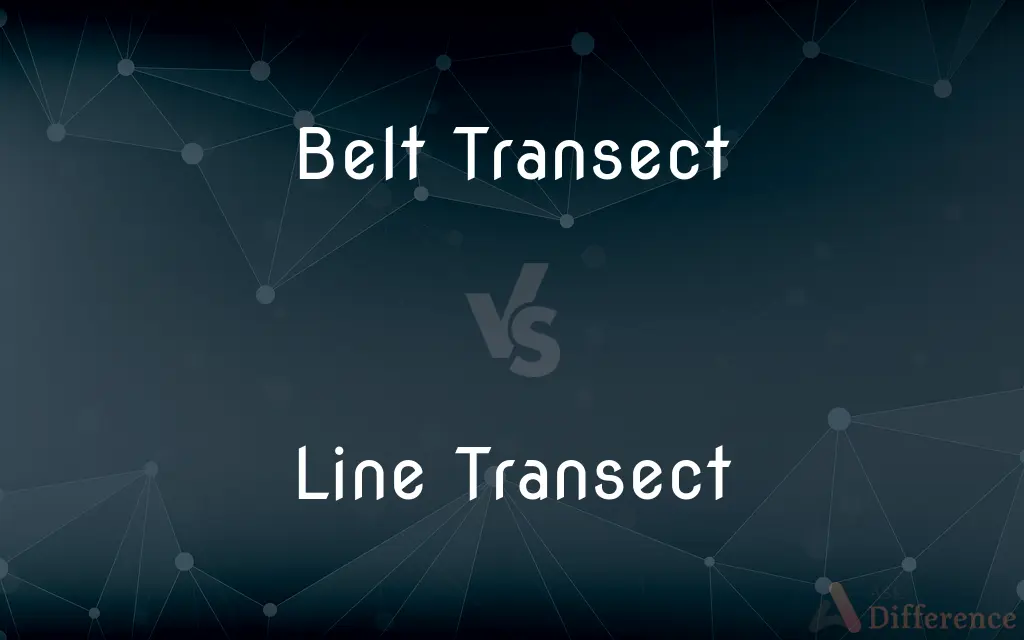Belt Transect vs. Line Transect — What's the Difference?
By Maham Liaqat & Fiza Rafique — Published on February 22, 2024
Belt transects involve a strip of habitat to assess species distribution and abundance, providing detailed spatial information. Line transects involve observations along a line, offering a simpler method for estimating population density and distribution.

Difference Between Belt Transect and Line Transect
Table of Contents
ADVERTISEMENT
Key Differences
A belt transect is a method used in ecological studies where a strip of land or habitat, typically defined by two parallel lines, is surveyed to collect data on the species present, their abundance, and distribution. This approach allows researchers to examine changes in species composition and environmental variables across a gradient or between habitats. Belt transects provide a comprehensive view of an area, including detailed spatial information about the distribution of organisms and their relationship with the environment.
In contrast, a line transect involves placing a line, such as a rope or tape, across the study area and recording the organisms encountered along this line. This method is particularly useful for estimating the density and distribution of species within a habitat. Line transects are less time-consuming and resource-intensive than belt transects, making them suitable for covering larger areas or when a rapid assessment is needed. However, they may offer less detailed information about the spatial variability of species and environmental factors.
The choice between a belt and a line transect often depends on the study's objectives, the type of data required, and the available resources. Belt transects are preferred when detailed information about a habitat and its species is needed, especially when studying changes across environmental gradients or in densely populated habitats. On the other hand, line transects are advantageous for large-scale surveys or when a quick approximation of species distribution and density is sufficient.
Both methods contribute valuable data to ecological research, conservation planning, and habitat management. They provide insights into species diversity, distribution patterns, and habitat utilization, which are crucial for understanding ecosystem dynamics and the impacts of environmental changes or human activities on natural habitats.
Comparison Chart
Scope
Studies a strip of habitat
Observations along a line
ADVERTISEMENT
Data Detail
Provides detailed spatial information
Offers a simpler overview of distribution
Time and Resources
More time-consuming and resource-intensive
Quicker and less resource-intensive
Suitability
Detailed studies of species composition and environmental variables
Estimating population density and distribution over larger areas
Application
Dense habitats or when detailed spatial data is required
Rapid assessments or large-scale surveys
Compare with Definitions
Belt Transect
Can be resource-intensive.
Setting up belt transects in the mountainous region required significant manpower and time.
Line Transect
Less detailed than belt transects.
Line transect data provided an overview but lacked finer habitat composition details.
Belt Transect
Used to examine changes across gradients.
Belt transects helped understand the species shift from the shore to the inland
Line Transect
Often used in population density studies.
Line transects facilitated the bird density study across different forest types.
Belt Transect
Ideal for detailed habitat analysis.
The belt transect method was crucial in assessing the recovery of the burned area.
Line Transect
A line-based method for estimating species distribution.
Line transects were used to estimate the deer population in the park.
Belt Transect
Provides comprehensive spatial information.
Belt transects revealed the gradient of plant species across the wetland.
Line Transect
Efficient in resource-limited studies.
With limited time, the research team opted for line transects to gather preliminary data.
Belt Transect
A method surveying a strip of land for ecological data.
Researchers used a belt transect to study the forest's undergrowth diversity.
Line Transect
Suitable for quick, large-area surveys.
Scientists employed line transects to survey the vast savannah ecosystem rapidly.
Common Curiosities
Do these methods require special equipment?
Basic equipment like measuring tapes, markers, and data recording sheets or devices are typically used, though more specialized tools may be needed for specific studies.
How do researchers decide the length of a transect?
The length depends on the study objectives, habitat size, and the spatial variability of the species or features being studied.
How is species abundance measured in these transects?
Abundance can be quantified by counting individuals, estimating coverage, or using sampling units like quadrats along the transect.
Can transect methods be applied in aquatic environments?
Yes, transects are used in marine and freshwater studies, often with adaptations like underwater tapes or GPS for defining transects.
How is data from transects analyzed?
Data analysis may involve statistical methods to assess species distribution, diversity indices, and correlations with environmental factors.
What is the main advantage of a belt transect over a line transect?
Belt transects provide more detailed spatial information about species distribution and environmental variables.
Can belt and line transects be used together?
Yes, combining both methods can provide comprehensive data, with line transects offering broad-scale insights and belt transects providing detailed information.
What are the limitations of transect methods?
Limitations include potential bias in species detection, the influence of environmental conditions, and the need for statistical considerations in design and analysis.
When might a line transect be preferred?
Line transects are preferred for rapid assessments or when surveying large areas due to their efficiency and lower resource requirements.
Can transect methods be automated?
Advances in technology, like drones and remote sensing, are increasingly used for data collection, offering new possibilities for automation.
Are transect studies influenced by the researcher's presence?
Yes, the presence of researchers can affect wildlife behavior; minimizing disturbance is crucial for accurate data collection.
What role do transects play in conservation efforts?
Transects help identify critical habitats, species at risk, and the effects of human activities, guiding conservation and management decisions.
What ethical considerations are involved in transect studies?
Ethical considerations include minimizing habitat disturbance, ensuring data accuracy, and respecting wildlife and local regulations.
How do environmental gradients affect transect studies?
Gradients can influence species distribution and abundance, making it important to align transects in a way that captures these variations.
How do seasonal changes affect transect data?
Seasonal variations can significantly impact species presence and behavior, requiring careful timing or repeated surveys across seasons for accurate assessments.
Share Your Discovery

Previous Comparison
Polystyrene vs. High Impact Polystyrene
Next Comparison
Buchner Funnel vs. Hirsch FunnelAuthor Spotlight
Written by
Maham LiaqatCo-written by
Fiza RafiqueFiza Rafique is a skilled content writer at AskDifference.com, where she meticulously refines and enhances written pieces. Drawing from her vast editorial expertise, Fiza ensures clarity, accuracy, and precision in every article. Passionate about language, she continually seeks to elevate the quality of content for readers worldwide.
















































